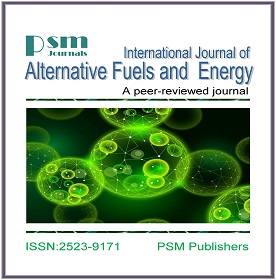Advance Microbial Fuel Cell for Waste to Energy Recovery: Need of Future Era for Sustainable Development
Microbial Fuel Cell (MFC) and Advancement in MFC Research
Abstract
EDITORIAL
Presently, entire population in the world is facing problem of water and energy crisis along with looking for sustainable wastewater treatment. Till date wastewater is considered as a source of waste; however, in present era it is considered as a resource, existing at wrong place, with waste to energy techniques. Bioelectrochemical system (i.e. Microbial Fuel Cell- MFC) is one of such novel technique utilizing the chemical energy of organic matter present in wastewater into the electrical energy by using microbes as a biocatalyst through number of electrochemical reactions. It consists of anodic and cathodic chamber separated by proton exchange membrane. During anodic oxidation of substrate, electrons (e-) and protons (H+) are generated by electrogenic bacteria and electrons are transferred through external electrical circuit. At cathodic site, electron and protons react with terminal electron acceptor (O2) to form water. Thus, simultaneous electricity generation and effective wastewater treatment can be achieved in MFC. This novel microbial electrochemical technology (MET) provide flexible platform for various electrochemical reactions and hence can be useful for removal of organic pollutants, nitrogen and sulfur rich wastewater, industrial effluent, lignocellulosic wastewater. Also, this system can be useful for biosensor application to sense the water quality parameters, to recover the heavy metals (i.e. Fe, Cr, Co) from wastewater, biohydrogen production, bioremediation, sanitation purpose, to operate different electronic appliances, robotics, for desalination, carbon capture, electro-coagulation, etc. To improve the wastewater treatment efficiency and by-product recovery, novel concept of hybrid / coupled MFC came forward with integrating the MET with conventional anaerobic digestion processes (like anaerobic digester, photobioreactor).
According to configuration, MFCs are classified as dual and single chambered, mediatorless vs. mediated, membrane vs. membraneless, batch vs. continuous mode MFC, tubular, upflow MFC. According to applications, MFCs are categorized as sediment MFC, constructed wetlands, microbial desalination cell, microbial carbon capture cell, etc. Generally, typical MFC configured with electrodes (anode and cathode), electrolyte, substrate, membrane / separator, electrical circuit. Performance of MFC system is governed by design constraints, electrode material and catalyst properties, wastewater characteristics, microbial conditions, operating conditions and several other factors. Over 9200 research publications are published till date as per Scopus data addressing various aspects and issues of MFC and its applications.
Over the decades of research, MFC technology capable to harvest electricity from nW to kW per m3 of wastewater treated, till this technology is away from commercialization and practical application. Though MFCs have shown significant increase in energy outputs over the past few years with advancement in research, still it could not be promising alternative for energy supplying ways. Performance of such MET is mainly restricted by several microbial, electrochemical, engineering, material science and economic constraints which reduced the power generation with relative to increase in volume of reactor. Low power density, high operating cost, higher voltage losses, lower Coulombic yield, non-electrogenic bacterial competition for food, voltage losses during stacking arrangement, poor kinetics of cathodic reactions, scaling up issues are major limitations of MFC restricting its use for practical application and commercialization.
In early 1911, Potter invented the electric charge production capability of bacteria in MET. Later, scientific community used MFC as a scientific tool to study the electrochemical, microbial, engineering and material research and its effect on performance. Considering practical utility of MFC at large scale, several researcher employed MFC in sediment for bioremediation, sanitation application for human waste treatment, industrial effluent treatment and other applications. One m3 capacity pilot plant at Queensland, Australia, 100 L capacity MFC at USA, MFC application in robotics, benthic MFC, 26 and 45 L capacity MFC treating synthetic wastewater at IIT Khargapur, India, 100 and 1500 L volume bioelectric toilet MFC developed at IIT Kharagpur are few of success stories conducted towards scaling up and practical applications. From industrial application point of view, several start-up companies such as Lebone (USA), Emefcy (Israel), Trophos Energy (USA), Plant-e (Netherlands), Hy-SyEnce (USA), IntAct Labs LLC (USA), Indian Oil Corporation Ltd. (India) and few others based on MFC technology have been already established and are trying to commercialize it (Jadhav et al., 2018). Such recent advances in MFC design emphasized on optimization of operating conditions and making it economical. However, demonstrations of practical scale MFC systems are required to take a step forward towards commercialization but it may pose new challenges and limitations which need to be addressed in a systematic manner in upcoming years.
Current research progress and power production by MFC technology warrants rethinking of applied value and niches for MFC systems for practical applications and commercialization (Jadhav et al., 2018). Journey of MFC from µL to m3 capacity in size and nW to kW/m3 power generation makes such system as a promising candidature to sit alongside other renewable energy technologies, while simultaneously curbing water pollution. With multidisciplinary efforts in order to contribute towards a greener future and sustainable development, bioelectrochemical system will be an integrated part of the advanced wastewater treatment processes in future.







